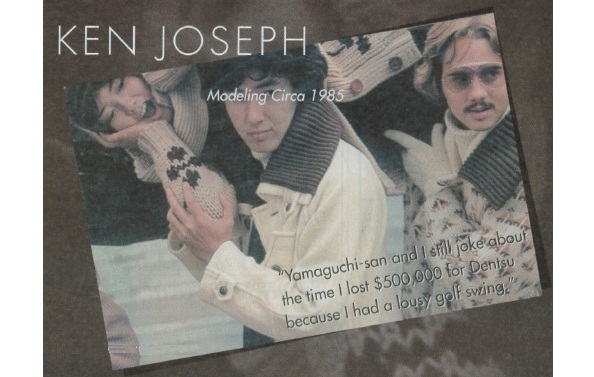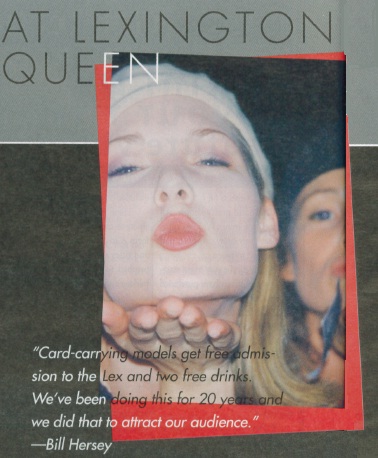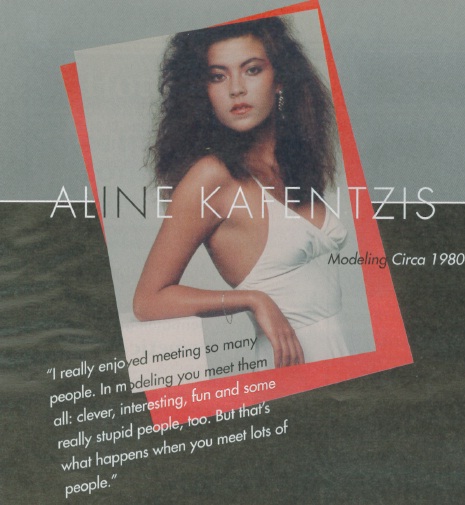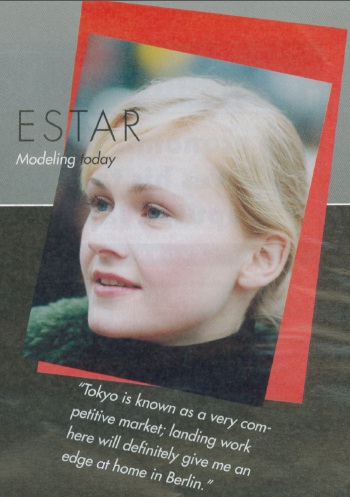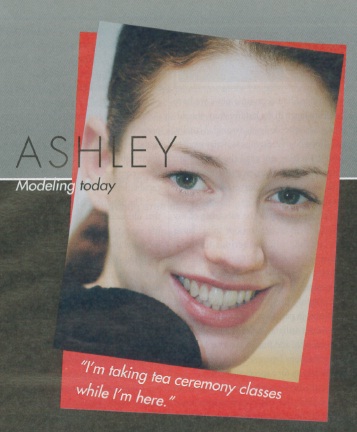By Jim Merk
Photos by Dov Friedmann
Every family has one; that person who absolutely hates getting photographed. Cajole, threaten, plead—no matter what you do, this person will simply not cooperate with your artistic ideas for a good photo—often making strange faces just to let you know how much they do not want to be in a photo. This same person will also always be the first one to complain, “See, I never take a good photograph.” Models don’t do this and so we are blessed (cursed?) on covers of magazines and newspapers with extremely beautiful people such as the very lovely Ashley whose eye graces this one.
Walking the streets of Roppongi, which is something every foreigner must do in Japan at least once or twice a year by law or risk ruining our collective gaijin reputation, one cannot help but notice very tall, strikingly featured, young women walking with utter purpose to some important destination.
Usually, this destination is the Lexington Queen, but the strut helps keep potential baddies at bay.
Having lived in Japan for nearly 13 years and in that time making at least 26 Roppongi visits, I have been struck by the wonderment of this phenomena at least twice (OK, twice per visit). Finally, I was forced to answer the questions that dwell within each of us, namely: “What are of these tall beautiful young people doing here?” “How do they find work?” “When did it become mandatory for them to patrol Roppongi Dori in search of dance tunes and free drinks after working hours?” At least those are my questions. If you have your own set of burning questions, you will have to do your own legwork, so to speak. I recommend it highly.
What I learned was that, over the years, modeling in Japan has developed into a well-oiled machine with agencies coming and going and expanding their reach and networks to tie up with agencies around the world. In fact, the reason this article deals primarily with women models isn’t because I am some sexist pig, but because the full scope of modeling in Japan is simply too big for one article. (That’s my story and I’m sticking to it.)
According to Japan Helpline founder, Ken Joseph Jr. who modeled in Japan about 15 years ago, “Japan was a great place to make lots of easy money as a model.” When I pressed for some idea of how much money was out there, he told me the following story.
“One time my agent called me and asked if I could play golf. I said, ‘sure,’ thinking that I could, at the very least, hit a golf ball for some shots. I did get a little nervous when he told me it was going to be a video, but I went for it anyway.
“The night before the shoot, we all met at a Narita Airport Hotel to get acquainted—my agent and a girl with whom I worked before and two very us Japanese professional golfers! I found out that night that the video was to be a golf lesson video and was a large Dentsu project. I was more nervous, but still didn’t lose too much sleep that night.
“The next day, we are hitting balls at the practice range when a bit of a commotion commences. It seems the sponsors were watching our practice. They took one look at my primitive hacks and cancelled the show on the spot! To this day, Yamaguichi-san teases me about the day I cost Dentsu $500,000.”
Such are the things models laugh about. Ken also told me that modeling at that point could turn ugly, but mostly for the women. Once, his girlfriend at the time (also a model) called sounding a bit hysterical. It turns out that as soon as she showed up on the set, the doors and windows were shut and locked and she was told to remove her clothing! Ken, then, as he does now, came to the rescue ensuring that the shot used revealed nothing more than a bare shoulder.
Foreigners in those days were in pretty high demand. A trend which had its roots much further back, but meant that if you lived here and had the desire, you could find work. Work was fun.
Aline Kafentzis, another model from yesteryear (early ’80s), told me: “The two best things about modeling were traveling and meeting people. I am sure I never would have made it to Fiji if it weren’t for modeling and I really enjoyed meeting so many different people. You meet a lot of people as a model—smart, funny, clever and, yes, some stupid ones. But that is the way it is when you meet a lot of people, of course.”
Trips to Fiji, $500,000 on cancelled projects? Well, this picture certainly appears lucrative. But as time marched on, and people saw an opportunity to make money, things changed.
Rebecca (Reb) Brenner, who modeled here in 1994, told me of the day she found out she was getting, well, robbed: “I was contracted to come to Japan, told about all of the money being made and thought that my experience would pay off with some choice jobs. I signed on for three months and was told to bring some money to cover the first weeks of living, rent and composites (a model’s calling card).
“After two weeks, I had no jobs and no money, so I had my dad wire money for rent to the real estate company. The transfer went directly to the apartment owner, who it turned out, was also my agent! She owned the apartment four other girls and I shared and had all of us paying rent. If we did get a job, she kept 40%, but if not she was getting ¥250,000 per person for rent. She’s got us coming and going.”
Agencies—real agencies, the ones that make their money from, say, modeling—hate to hear these stories. Sachiko Onishi, vice president of Satoru Japan, told me that Japan’s Modeling Association currently has about 18 members and the procedure they follow is much different.
“We not only take care of our models’ rent and airfare and composite, but also guarantee a minimum salary. If a model doesn’t get work, it isn’t her fault; it is the agency’s.
“Small-time operators like that have really had a negative impact on the market. For example, today you will find far fewer American models giving it a try. The number of women from Eastern Europe who, from a lack of information, may fall prey to these schemes, is sky rocketing.”
A typical agency (association member) set-up in Japan works like this: Representatives in New York, Milan, London and Paris keep their eyes open for new talent. They will recruit models on behalf of the agencies, sending them photos and measurements. Once they get a go-ahead from the Tokyo office, the agent will set up an interview to determine maturity level and personality. If, after all of that, the model meets approval, she will make the trip to Japan.
The contracts written differ from agency to agency, but most follow a similar pattern. If it is a model’s first trip, he or she will come over on a contingency contract. If she lands work within two weeks, the contract will be extended for an additional two to four weeks. If not, she will make her way home with her guarantee, but nothing for her portfolio.
If the model has a really good portfolio or has been to Japan before, the contract might be set up for six to eight weeks from the outset. The guarantee will be on the same par, but the potential for work increases greatly.
Agency contracts take 20% commission. Another 20% goes to tax and the remaining 60% is paid to the model. Payment, though, is interesting. Models get the bulk of their salary very near the end of their stay—usually two or three days before they leave. Models are paid a living allowance of only ¥10,000 per week! Which, I guess, really helps keep them focused on work.
Work it is, too. Agencies will set up as many auditions as possible. While the models may never see it first-hand, the competition is staggering. Paul Jeffers of Jun Ashida Co. Ltd. says that for their typical runway event, they will audition, “well over 100 girls for the 18 to 25 positions available.” Just for one job.
To look at it another way, each month an agency the size of Satoru will bring an average of 12 women models to Japan. Onishi estimates that each of the member agencies will do the same. If you estimate the number of agencies not part of the association to be 24. Which of course brings the total number of foreign models in Tokyo seeking work to about 500 per month. To enter the fray, you need to know the business and have pretty thick skin.
“Auditioning in Tokyo is different,”says Estar Dalitz, a model from Berlin. “First, it is exhausting. I will audition until about 8 p.m. and just collapse into bed at night. During the audition, I am not supposed to speak unless spoken to and, in general, they treat you pretty roughly. I guess they don’t want anyone to get their hopes up and be disappointed later. I do have to say, though, that once on the job, you are treated like royalty.”
The pay may surprise you. A magazine cover may earn a model between ¥30,000 and ¥50,000 and take half the day to shoot. A catalog job brings in anywhere from ¥80,000 to ¥200,000 and can take three or four days. Music videos, ¥40,000. Commercials are prized for their residual payments. If it is a large campaign, models keep getting money; if it was popular and is repeated, so too, the payments. For every commercial, though, there are hundreds of ¥10,000 jobs. It takes a bit of luck, to say the least.
When asked what it means to have gotten work in Tokyo, she says, “A lot. Tokyo is known in modeling circles to be very competitive; getting work here will gready improve my marketability back home.”
Not all of the girls, though, visit Tokyo for monetary or marketability reasons. Ashley Holland Arbaugh, who graces our front page, came to soak in Japan’s culture. “I am taking tea ceremony lessons on the weekends while I am here,” she says. “I have already bought my house, so I before I start university, I wanted to see more of the world.”
She has seen quite a bit already. Born in Michigan, she has spent the better part of the last three years modeling in Paris, London and Milan. She now resides and models in New York. When asked about her goals for modeling, she laughs.
“I don’t really have any. I started modeling a bit late at 17 and in the past three years have got a lot from it. I am looking forward to studying design and ceramics,” she says.
Estar was just as sober regarding her work. “My modeling career was a bit of a fluke,” she says. “The girls who want careers as models start early, 13 or 14. Once they hit, they often pull out of school and devote themselves to the job. I am 21 and only started three years ago. I model during semester breaks at university and enjoy the work I get.”
These two are, perhaps, indicative of the maturity level of the models good agencies bring over. The “smaller agency women” tell a different story of hopes and dreams. “I want to be in movies,” says April Smith. “I just love Kim Basinger, and if you think about it, a lot of top movie stars started as models.”
April modeled here in 1995 and spent most of her nights at the Lexington Queen hoping to see a movie star. A common practice. “I don’t know how some of these people even have the energy to audition,” says Bill Hersey. “They come in, drink the night away and end up taking the first morning train home. How can they possibly be fit?”
Fit or not, they are pursuing a dream, no matter how implausible it might seem to others. One person who did model here, eventually making it spectacularly big is none other than George Clooney. So who is to say what is fantasy and what is possible?
Still, most of the truly professional models work hard, understand the complexities and the competition that is Tokyo and have a healthy understanding of what they can expect from the experience.
So perhaps in your family you also have the person that always mugs for the camera, oblivious and happy. This is your model candidate. So modeling isn’t what it used to be; still it isn’t too bad. And once you get work, you have the satisfaction of knowing you can make it as a model anywhere.

